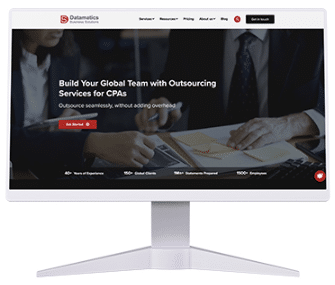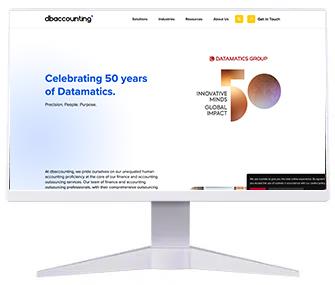Most marketing teams know that data matters. Yet very few treat data problems as an immediate concern. Nearly 45% of the marketers use inaccurate and outdated data for business decisions. Poor data quality doesn’t just slow you down. Studies have shown that poor B2B data can cost organizations around $15 million every year. Further studies show that bad data can eat up to 20% of total revenue and cause up to 30% of operating expenses to go to waste.
A quick search about bad data and its impact on marketing is enough to reveal the scale of the problem. And trust me when I say this. It is not a pleasant picture.
Dirty data doesn’t create chaos overnight. It works quietly in the background. It slowly drains your campaign’s performance. Every wrong email address, duplicate contact, and missing data field chips away at your results. And if it is left unchecked, it becomes a ticking time bomb that could quietly derail your 2026 marketing campaigns! Even before it begins.
To help you prepare for the year ahead and safeguard your marketing performance, this blog breaks down the real implications of dirty data, why B2B data quality deserves serious attention, and why data cleansing has become more critical than ever before.
What is Dirty Data?
Imagine this. You are about to launch a new product. You have spent weeks planning the campaign, and you are ready to spread the word. You have a list of 1,000 contacts who you believe are your ideal audience. You craft the perfect email with a catchy subject line, great visuals, and strong call to action. Then you hit the send button.
But nothing happens. Barely anyone opens the email. Conversions? Zero. Your product launch feels like it has fallen flat.
When you dig deeper, you discover the real problem. Over 700 of those email addresses were invalid or outdated. The email never even reached the people you wanted to target.
This is what dirty data looks like.
Dirty data is information that is inaccurate, incomplete, duplicated, or outdated.
It comes in many forms. It can be a misspelled name, a wrong email address, an outdated phone number, or a missing company field. Sometimes it is deeper. It can be mismatched values, inconsistent country codes, or conflicting CRM entries.
At first glance, dirty data looks like small admin mistakes. But these “small errors” multiply fast across systems. One incorrect contact record can sync across marketing automation tools, CRMs, analytics dashboards, and ad platforms. The result? It can corrupt entire campaigns.
And once that happens, your campaigns stop targeting real people. They start targeting ghosts.
 Select an element to maximize. Press ESC to cancel.
Select an element to maximize. Press ESC to cancel.Key Takeaway
Dirty data isn’t just a few typos or missing fields. It is a hidden problem that spreads across systems and ruins marketing campaigns. When your data is inaccurate or outdated, your marketing doesn’t reach real people. It targets ghosts
Why B2B Data Quality Matters for Marketing in 2026?
Marketing runs on three engines: reach, relevance, and measurement. When your data is bad, all three break down. Let’s explore.
Bad B2B data quality can curb your reach. You waste ad dollars on invalid or duplicate contacts.
When it comes to relevance, bad data is a major hurdle. You send messages to the wrong segments or outdated personas.
And when bad data plagues your campaigns, your analytics no longer show the truth. Reports are wrong and decisions are based on false numbers. So accurate measurement flies out of the window.
You can tweak your messages and creatives as much as you want. Or say you can budget all you want. But if the data feeding your campaigns is unreliable, even the best strategy will collapse.
As we prepare for 2026, we should remember that marketing is getting a facelift. AI-driven targeting, automation, and personalization are set to dominate marketing. With so many major changes happening, the quality of your data will determine whether your campaigns succeed or fail spectacularly.
Key Takeaway
No matter how creative your campaigns are, bad data breaks everything. Be it your reach, your relevance, or your results. With AI-driven marketing set to rule 2026, your B2B data quality will be the deciding factor between campaign success and failure.
 Select an element to maximize. Press ESC to cancel.
Select an element to maximize. Press ESC to cancel.The Scale of the Damage Caused by Bad B2B Data Quality
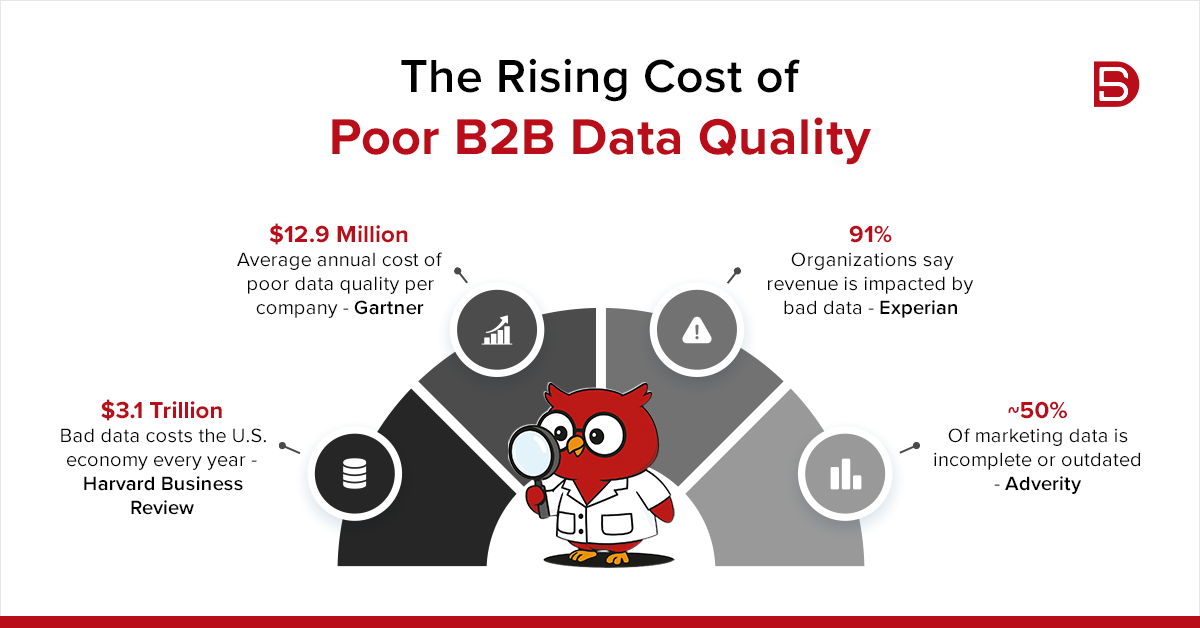
- According to Harvard Business Review, bad data costs the U.S. economy $3.1 trillion annually.
- Gartner estimates that poor B2B data quality costs companies an average of $12.9 million each year.
- Experian’s Global Data Management Report found that 91% of organizations say their revenue is affected by bad data.
- Adverity reported that nearly 50% of marketing data used for decision-making is incomplete, inaccurate, or outdated.
How Dirty Data Sabotages Your Marketing?
1. Acquisition and Paid Media
When your contact lists are full of duplicates or outdated profiles, you waste your ad budget showing the same ads to the same person multiple times. Or worse. You show your ads to people who no longer exist in your target audience. A report from Forrester highlighted that 26% of marketing campaigns were hurt by poor B2B data quality, on average.
If you are paying for every impression or click, every invalid record adds unnecessary cost. This directly increases your cost per lead (CPL) and cost per acquisition (CPA) while lowering conversion rates.
 Select an element to maximize. Press ESC to cancel.
Select an element to maximize. Press ESC to cancel.2. Personalization and Content
Personalization is supposed to make marketing more relevant. However, 61% of companies may be losing sleep over the specter of inaccurate data muddying their AI-driven personalization efforts. When data is wrong, be it misspelled name or outdated job title, your “personalized” messages become irrelevant or even irritating.
Imagine sending a “Welcome, Sarah!” email to someone named Sam. Or promoting enterprise software to a student. Small mistakes like these break trust and hurt engagement rates.
 Select an element to maximize. Press ESC to cancel.
Select an element to maximize. Press ESC to cancel.3. Email and Deliverability
Email addresses in marketing databases naturally decay by approximately 22.5% to 30% each year. This means nearly one-quarter of your hard-won contacts become invalid, outdated, or irrelevant annually.
This rapid decay of data can directly lead to hard bounces, damage your reputation (your emails landing in spam), and result in a wasted budget spent on email marketing.
Bad data is a plague for email marketing. Once email providers start marking your messages as spam, recovery is tough.
Clean data keeps your domain reputation strong and ensures your campaigns land where they should — in the inbox.
4. Measurement and Attribution
When your tracking IDs, UTM parameters, or CRM fields don’t align, your campaign reporting becomes unreliable. You can’t tell which channels perform best.
This is every marketer’s worst nightmare. You end up shifting budget away from channels that work just because your data said otherwise.
5. Compliance and Privacy
With privacy laws tightening across the globe, wrong consent records or outdated opt-in flags can mean legal trouble.
The GDPR and CCPA both require you to keep customer data accurate and up to date. If you fail to do that, you risk hefty fines and public trust.
Key Takeaway
Dirty data quietly sabotages every part of marketing. Be it paid ads or message personalization, campaign measurement or compliance, bad data inflates costs, damages engagement, skews reports, and can even lead to legal risks. To put it simply, without clean data, marketing becomes a gamble.
You can also read: What is B2B Data? Uses, Types & Complete Guide
 Select an element to maximize. Press ESC to cancel.
Select an element to maximize. Press ESC to cancel. Select an element to maximize. Press ESC to cancel.
Select an element to maximize. Press ESC to cancel. Select an element to maximize. Press ESC to cancel.
Select an element to maximize. Press ESC to cancel. Select an element to maximize. Press ESC to cancel.
Select an element to maximize. Press ESC to cancel. Select an element to maximize. Press ESC to cancel.
Select an element to maximize. Press ESC to cancel. Select an element to maximize. Press ESC to cancel.
Select an element to maximize. Press ESC to cancel. Select an element to maximize. Press ESC to cancel.
Select an element to maximize. Press ESC to cancel. Select an element to maximize. Press ESC to cancel.
Select an element to maximize. Press ESC to cancel. Select an element to maximize. Press ESC to cancel.
Select an element to maximize. Press ESC to cancel. Select an element to maximize. Press ESC to cancel.
Select an element to maximize. Press ESC to cancel. Select an element to maximize. Press ESC to cancel.
Select an element to maximize. Press ESC to cancel. Select an element to maximize. Press ESC to cancel.
Select an element to maximize. Press ESC to cancel. Select an element to maximize. Press ESC to cancel.
Select an element to maximize. Press ESC to cancel. Select an element to maximize. Press ESC to cancel.
Select an element to maximize. Press ESC to cancel. Select an element to maximize. Press ESC to cancel.
Select an element to maximize. Press ESC to cancel. Select an element to maximize. Press ESC to cancel.
Select an element to maximize. Press ESC to cancel. Select an element to maximize. Press ESC to cancel.
Select an element to maximize. Press ESC to cancel. Select an element to maximize. Press ESC to cancel.
Select an element to maximize. Press ESC to cancel. Select an element to maximize. Press ESC to cancel.
Select an element to maximize. Press ESC to cancel. Select an element to maximize. Press ESC to cancel.
Select an element to maximize. Press ESC to cancel. Select an element to maximize. Press ESC to cancel.
Select an element to maximize. Press ESC to cancel. Select an element to maximize. Press ESC to cancel.
Select an element to maximize. Press ESC to cancel. Select an element to maximize. Press ESC to cancel.
Select an element to maximize. Press ESC to cancel. Select an element to maximize. Press ESC to cancel.
Select an element to maximize. Press ESC to cancel. Select an element to maximize. Press ESC to cancel.
Select an element to maximize. Press ESC to cancel. Select an element to maximize. Press ESC to cancel.
Select an element to maximize. Press ESC to cancel. Select an element to maximize. Press ESC to cancel.
Select an element to maximize. Press ESC to cancel. Select an element to maximize. Press ESC to cancel.
Select an element to maximize. Press ESC to cancel. Select an element to maximize. Press ESC to cancel.
Select an element to maximize. Press ESC to cancel. Select an element to maximize. Press ESC to cancel.
Select an element to maximize. Press ESC to cancel. Select an element to maximize. Press ESC to cancel.
Select an element to maximize. Press ESC to cancel.The Root Causes of Dirty Data
Dirty data doesn’t appear overnight. It builds up slowly and gradually. What would have been one misspelled name or one incorrect phone number could accumulate to become dirty data. It comes from everyday processes that go unchecked.
Here is where it often starts.
- Manual data entry errors — A typo during form fill or CRM update.
- Disconnected systems — Marketing tools and CRMs that don’t sync properly.
- Lack of validation — Forms that don’t check for incorrect or duplicate entries.
- No identity resolution — Multiple systems creating different versions of the same customer.
- No data ownership — When no one is responsible for monitoring data accuracy.
These are practical issues, not technical mysteries. And that is good news. Why you ask? Because it means they can be fixed.
Frequently Asked Questions about B2B Data Quality
Q: What exactly is B2B data quality?
A: B2B data quality aligns to data that is accurate, complete, consistent, and ready for use by marketing leaders in decision making.
 Select an element to maximize. Press ESC to cancel.
Select an element to maximize. Press ESC to cancel. Select an element to maximize. Press ESC to cancel.
Select an element to maximize. Press ESC to cancel. Select an element to maximize. Press ESC to cancel.
Select an element to maximize. Press ESC to cancel.Q: How often should I clean my data?
A: Run daily checks for new entries and monthly audits for your main database.
 Select an element to maximize. Press ESC to cancel.
Select an element to maximize. Press ESC to cancel.Q: Can dirty data really impact campaign ROI?
A: Yes. Poor data reduces deliverability, skews metrics, and causes ad budget waste. It directly affects ROI.
Q: Can this process be automated?
A: Yes. Datamatics’ agentic AI, DR. D.A.T.A. can automate most cleaning, enrichment, and monitoring tasks while keeping humans in control. It takes a hybrid approach.
Q: What are early signs of bad data?
A: Rising bounce rates, declining open rates, mismatched reports, and low campaign attribution accuracy.
The Marketer’s 6-Step B2B Data Quality Checklist
You don’t need a massive overhaul to start improving data quality. Start small and scale from there.
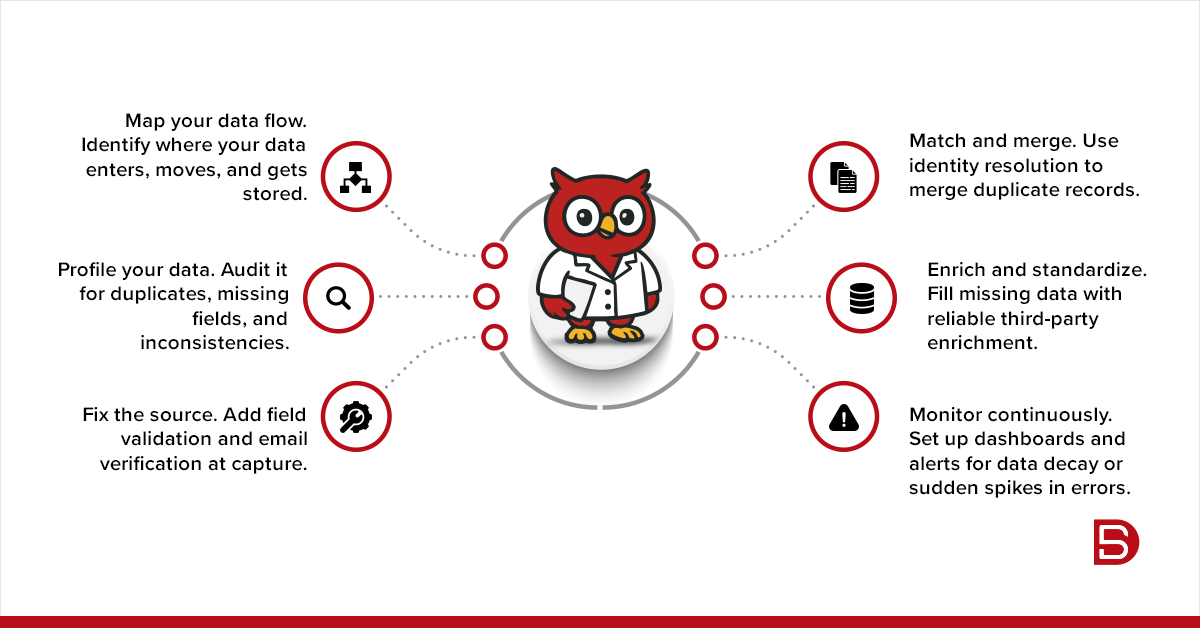
- Map your data flow. Identify where your data enters, moves, and gets stored.
- Profile your data. Audit it for duplicates, missing fields, and inconsistencies.
- Fix the source. Add field validation and email verification at capture.
- Match and merge. Use identity resolution to merge duplicate records.
- Enrich and standardize. Fill missing data with reliable third-party enrichment.
- Monitor continuously. Set up dashboards and alerts for data decay or sudden spikes in errors.
You will see visible improvements. Be it cleaner reports, better targeting, or reduced campaign waste, by following these steps, you can see improvement in your B2B data quality within weeks.
 Select an element to maximize. Press ESC to cancel.
Select an element to maximize. Press ESC to cancel.How to Measure the ROI of B2B Data Quality?
You know the implications of bad data. Sabotaged campaigns and wasted budget being the biggest red flags. So, to justify data cleansing, you need to show measurable results. You can track these metrics before and after data cleanup.
a. When you have bad data, your email bounce rate will be extremely high. With data cleansing services, you should see a sharp decline in bounce rate.
b. Bad data increases your cost per lead. Good quality data will decrease cost per lead as your targeting improves.
c. Low conversion rates from a campaign can be attributed to bad data. Once you get access to good B2B data quality, you should see a rise in conversion rates as segments become more accurate.
d. Bad data can impact campaign attribution clarity. When you have fewer “unknown” conversions, you should know that you have access to good data.
e. If you are spending a lot of time fixing data, it goes without saying that you have bad data. When you have good B2B data, your team will spend less time cleaning spreadsheets manually.
Even modest improvements can translate into major cost savings. This is true, especially when campaigns scale across regions or multiple business units.
 Select an element to maximize. Press ESC to cancel.
Select an element to maximize. Press ESC to cancel. Select an element to maximize. Press ESC to cancel.
Select an element to maximize. Press ESC to cancel.Key Takeaway
Clean data directly impacts measurable marketing outcomes. It will lower bounce rates, reduce cost per lead, and increase conversions. It is the difference between guessing and knowing what works
 Select an element to maximize. Press ESC to cancel.
Select an element to maximize. Press ESC to cancel.Common Objections to Improving B2B Data Quality (and Straight Answers)
“We don’t have time.”
You don’t need a full overhaul. Start with your email list. A clean list alone can increase deliverability and open rates fast.
“It’s too expensive.”
Calculate your ad waste. Even a 10% reduction in duplicate or invalid contacts can save thousands per campaign.
“We’re a small team.”
That is exactly why it matters. Smaller teams can’t afford to waste time or budget caused by bad data.
 Select an element to maximize. Press ESC to cancel.
Select an element to maximize. Press ESC to cancel.The Tools and Approaches That Actually Help Improving B2B Data Quality
Clean data isn’t just a one-time task. It is a process. Ask any data person, and they will say it is a system. You need the right mix of tools and processes to ensure good data quality.
a. Validation at Capture: When you collect data, ensure that you employe email and phone verification to prevent errors at entry. This one small step can be crucial to prevent dirty data from ever creeping into your CRM.
b. Deduplication Tools: You can merge overlapping records automatically with deduplication tools. These tools often use AI to find duplicate data.
c. Enrichment APIs: You can add firmographic or demographic data to strengthen segmentation. This helps you understand your audience beyond basic contact details like company size, industry, or role. With richer insights, your campaigns become more precise and relevant to each target group.
d. Central Data Hub or CDP: You can opt for a central data hub. This hub can be used to create a unified customer profile across all channels.
e. Monitoring Dashboards: You can hire a staff member to keep an eye on the health of your data and issue alerts when something seems off. Frequent monitoring enables you to identify problems early on before they become more serious and result in reporting irregularities or campaign blunders.
But without accountability, even the best tools fall short. Assign a marketing operations owner or data steward to oversee the quality of data across all systems.
 Select an element to maximize. Press ESC to cancel.
Select an element to maximize. Press ESC to cancel.Key Takeaway
Keeping data clean requires constant effort rather than a one-time cleansing. Even the greatest technology cannot maintain the health of your data if there are unclear ownership and accountability.
You can also read: 5 Proven CRM Data Management Strategies for Enhanced B2B Data Quality
 Select an element to maximize. Press ESC to cancel.
Select an element to maximize. Press ESC to cancel. Select an element to maximize. Press ESC to cancel.
Select an element to maximize. Press ESC to cancel. Select an element to maximize. Press ESC to cancel.
Select an element to maximize. Press ESC to cancel. Select an element to maximize. Press ESC to cancel.
Select an element to maximize. Press ESC to cancel. Select an element to maximize. Press ESC to cancel.
Select an element to maximize. Press ESC to cancel. Select an element to maximize. Press ESC to cancel.
Select an element to maximize. Press ESC to cancel. Select an element to maximize. Press ESC to cancel.
Select an element to maximize. Press ESC to cancel. Select an element to maximize. Press ESC to cancel.
Select an element to maximize. Press ESC to cancel. Select an element to maximize. Press ESC to cancel.
Select an element to maximize. Press ESC to cancel. Select an element to maximize. Press ESC to cancel.
Select an element to maximize. Press ESC to cancel. Select an element to maximize. Press ESC to cancel.
Select an element to maximize. Press ESC to cancel. Select an element to maximize. Press ESC to cancel.
Select an element to maximize. Press ESC to cancel. Select an element to maximize. Press ESC to cancel.
Select an element to maximize. Press ESC to cancel. Select an element to maximize. Press ESC to cancel.
Select an element to maximize. Press ESC to cancel. Select an element to maximize. Press ESC to cancel.
Select an element to maximize. Press ESC to cancel. Select an element to maximize. Press ESC to cancel.
Select an element to maximize. Press ESC to cancel. Select an element to maximize. Press ESC to cancel.
Select an element to maximize. Press ESC to cancel. Select an element to maximize. Press ESC to cancel.
Select an element to maximize. Press ESC to cancel. Select an element to maximize. Press ESC to cancel.
Select an element to maximize. Press ESC to cancel. Select an element to maximize. Press ESC to cancel.
Select an element to maximize. Press ESC to cancel. Select an element to maximize. Press ESC to cancel.
Select an element to maximize. Press ESC to cancel. Select an element to maximize. Press ESC to cancel.
Select an element to maximize. Press ESC to cancel. Select an element to maximize. Press ESC to cancel.
Select an element to maximize. Press ESC to cancel. Select an element to maximize. Press ESC to cancel.
Select an element to maximize. Press ESC to cancel. Select an element to maximize. Press ESC to cancel.
Select an element to maximize. Press ESC to cancel. Select an element to maximize. Press ESC to cancel.
Select an element to maximize. Press ESC to cancel. Select an element to maximize. Press ESC to cancel.
Select an element to maximize. Press ESC to cancel. Select an element to maximize. Press ESC to cancel.
Select an element to maximize. Press ESC to cancel. Select an element to maximize. Press ESC to cancel.
Select an element to maximize. Press ESC to cancel. Select an element to maximize. Press ESC to cancel.
Select an element to maximize. Press ESC to cancel. Select an element to maximize. Press ESC to cancel.
Select an element to maximize. Press ESC to cancel. Select an element to maximize. Press ESC to cancel.
Select an element to maximize. Press ESC to cancel. Select an element to maximize. Press ESC to cancel.
Select an element to maximize. Press ESC to cancel.How Datamatics Can Help? Introducing Dr. D.A.T.A. for Data Cleansing
With 50 years in the industry, Datamatics has introduced Dr. D.A.T.A., an agentic AI solution built for data cleansing and data enrichment. It is not just another data cleansing solution. It is a continuous improvement engine that learns from your data patterns and automates most of the heavy lifting.
Once you integrate your CRM with Dr. D.A.T.A., it starts by scanning the data. It can then detect duplicates, incomplete records, and inconsistencies. Using both deterministic rules and probabilistic matching, Dr. D.A.T.A. automatically merges duplicate records, corrects inconsistencies, and standardizes formats (like phone numbers and addresses). This gives you one reliable version of every contact.
When data is missing, Dr. D.A.T.A. pulls sources from verified internal and third-party sources to fill gaps. Dr D.A.T.A. has access to 230+ million data records from across 40 industries. This helps create complete customer profiles that improve targeting and segmentation accuracy.
Furthermore, Dr. D.A.T.A. keeps a watch in the background. It flags errors, alerts teams when decay rates spike, and even auto-corrects common issues. You get ongoing protection and not just a one-time fix.
Additionally, Dr D.A.T.A. enforces data capture rules, consent policies, and retention timelines. It also maintains full data lineage. This means you always know where a record originated and how it has changed over time. The data available with Datamatics’ data cleansing services boasts 95% accuracy and is GDPR complaint.
By reducing duplication, improving accuracy, and enforcing governance, Dr. D.A.T.A. helps you protect every marketing dollar. In 2026, when campaigns depend more on automation and AI, that accuracy will be your competitive advantage.
Interested in learning more about Dr. D.A.T.A. and how it can help you improve your B2B data quality? Get in touch with our experts today!
A Realistic 2026 Action Plan to Maintain B2B Data Quality
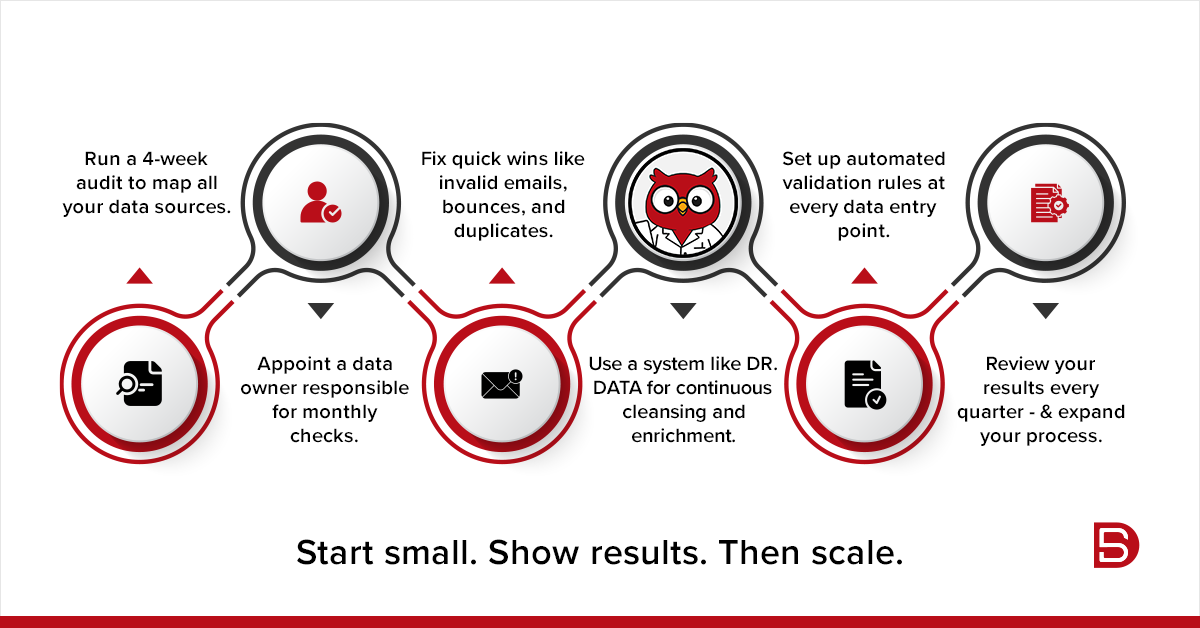
- Run a 4-week audit to map all your data sources.
- Fix quick wins like invalid emails, bounces, and duplicates.
- Set up automated validation rules at every data entry point.
- Appoint a data owner responsible for monthly checks.
- Use a system like DR DATA for continuous cleansing and enrichment.
- Review your results every quarter — and expand your process.
Start small. Show results. Then scale.
 Select an element to maximize. Press ESC to cancel.
Select an element to maximize. Press ESC to cancel.In Closing — Treat B2B Data as a Campaign Asset
Data quality is no longer an IT problem. It is a marketing necessity. As we prepare for 2026, we have to remember that campaigns will be faster, more automated, and more data-driven than ever. If your data isn’t accurate, every automated action you take will amplify the wrong outcome.
The solution is not complicated. It is a consistent effort. Map your data. Clean it. Monitor it. And keep your data healthy.
Because the only thing worse than having no data is trusting the wrong data.
Subscribe to our newsletter to stay ahead of the latest data trends.

James Libera

